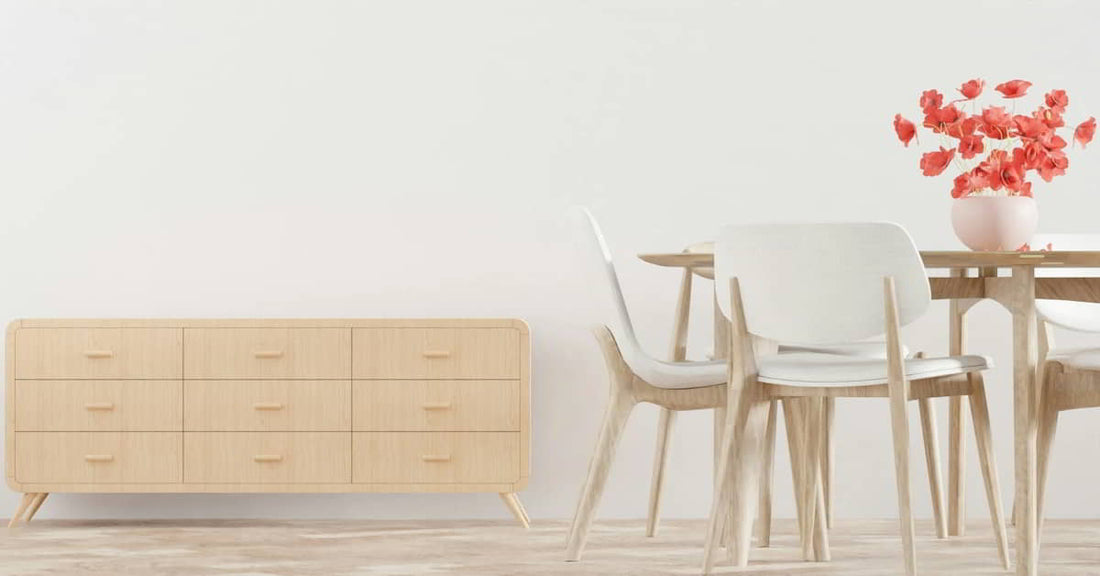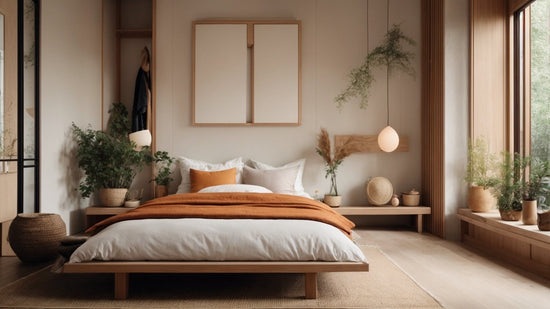Scandinavian Interior Design: Minimalism with a Cozy Twist

1. Understanding Scandinavian Interior Design
Scandinavian design is known for its simplicity, functionality, and minimalism, which are evident in various aspects:
- Clean lines: Straightforward and uncluttered lines create a sense of openness and space in Scandinavian interiors.
- Neutral color palettes: The use of soft, muted tones such as white, gray, beige, and light wood creates a serene and calming atmosphere.
- Functional furniture: Scandinavian furniture is designed to be practical and efficient, often featuring clean lines, sleek silhouettes, and multifunctional features.
- Ample natural light: Large windows, minimal window treatments, and light-colored walls maximize natural light, which is essential in the Nordic region with its long, dark winters.
This design style emerged in the 1950s in the Nordic countries of Denmark, Norway, Sweden, Finland, and Iceland, and it continues to influence contemporary interior design worldwide.
2. Incorporating Natural Elements
How can you incorporate natural elements into Scandinavian design?
Natural elements bring warmth and texture to Scandinavian interiors:
- Wood: Use light-toned woods like pine, birch, or ash for furniture and flooring.
- Stone: Add natural stone accents like marble or granite in kitchens and bathrooms.
- Plants: Bring the outdoors in with greenery like succulents, ferns, or fiddle leaf figs.
3. Creating a Minimalist Aesthetic
Why is minimalism important in Scandinavian design?
Minimalism promotes a sense of calm and clutter-free living:
- Declutter: Keep spaces clean and organized with clever storage solutions.
- Less is More: Choose quality over quantity when selecting furniture and decor.
- Focus on Function: Opt for furniture with clean lines and multifunctional design.
4. Embracing Hygge
What is hygge, and how does it relate to Scandinavian design?
Hygge is a Danish concept that emphasizes coziness, comfort, and well-being:
- Soft textiles: Add warmth with plush blankets, sheepskin rugs, and knit throws.
- Candlelight: Create a cozy atmosphere with candles and dimmable lighting.
- Socializing: Host gatherings with friends and family in welcoming, intimate spaces.
5. Choosing a Neutral Color Palette
How can you use color in Scandinavian design?
Scandinavian interiors often feature soft, muted tones:
- White: Use white as a base color to maximize natural light and create a sense of spaciousness.
- Gray: Add depth and sophistication with shades of gray for walls, furniture, and accessories.
- Earthy Accents: Introduce warmth with accents of beige, taupe, or soft pastels.
6. Incorporating Functional Furniture
What are some examples of functional furniture in Scandinavian design?
Scandinavian furniture is designed to be both stylish and practical:
- Modular Sofas: Choose sofas with clean lines and modular components for flexibility.
- Multipurpose Tables: Opt for coffee tables with hidden storage or extendable dining tables.
- Compact Storage: Use bookcases, shelving units, and cabinets to keep clutter at bay.
7. Maximizing Natural Light
Why is natural light important in Scandinavian design?
Natural light enhances the airy, open feel of Scandinavian interiors:
- Large Windows: Install floor-to-ceiling windows to maximize daylight and connect with nature.
- Sheer Curtains: Use lightweight curtains or blinds to maintain privacy without blocking sunlight.
- Mirrors: Place mirrors strategically to reflect light and create the illusion of space.
8. Incorporating Textural Contrast
How can you add texture to Scandinavian interiors?
Textural contrast adds interest and depth to minimalist spaces:
- Soft Fabrics: Layer textiles like linen, cotton, and wool for visual and tactile warmth.
- Natural Materials: Mix wood, stone, metal, and leather for a harmonious blend of textures.
- Rugs and Throws: Add rugs, cushions, and throws with different textures to soften hard surfaces.
9. Creating Cozy Nooks
What are some examples of cozy nooks in Scandinavian homes?
Cozy nooks provide intimate spaces for relaxation and contemplation:
- Reading Corner: Set up a comfortable armchair with a side table and a floor lamp for reading.
- Window Seat: Install a cushioned window bench with throw pillows for a cozy spot with a view.
- Fireside Lounge: Arrange seating around a fireplace or wood-burning stove for warmth and ambiance.
10. Adding Geometric Patterns
How can you incorporate geometric patterns into Scandinavian design?
Geometric patterns add visual interest and modern flair to minimalist interiors:
- Graphic Prints: Choose rugs, cushions, or artwork with bold geometric designs as focal points.
- Subtle Accents: Introduce geometric patterns in small doses through textiles, wallpaper, or accessories.
- Monochrome Schemes: Stick to black and white or neutral color palettes for a cohesive look.
11. Incorporating Scandinavian Artwork
What types of artwork are popular in Scandinavian design?
Scandinavian artwork reflects the region's natural beauty and cultural heritage:
- Nature Scenes: Display landscape paintings, photography, or prints of Nordic landscapes.
- Minimalist Prints: Choose abstract or minimalist artwork with simple lines and shapes.
- Textile Art: Hang woven tapestries, macrame wall hangings, or embroidered textiles for texture.
12. Designing a Scandinavian Kitchen
How can you create a Scandinavian-inspired kitchen?
Scandinavian kitchens blend form and function with clean lines and practical features:
- White Cabinetry: Install white or light-colored cabinets for a bright and airy feel.
- Natural Materials: Use wood or stone countertops and backsplashes for a warm, organic look.
- Open Shelving: Display cookware, dishes, and utensils on open shelves for easy access and visual interest.
13. Designing a Scandinavian Bedroom
What are some key elements of a Scandinavian-inspired bedroom?
Scandinavian bedrooms are serene retreats with a focus on comfort and simplicity:
- Minimalist Bedding: Choose crisp white or neutral bedding with clean lines and luxurious textures.
- Cozy Layers: Add warmth with layers of blankets, throws, and cushions in soft, natural fabrics.
- Functional Storage: Opt for bedside tables, dressers, or under-bed storage solutions to keep clutter at bay.
14. Creating Scandinavian Workspaces
How can you design a Scandinavian-inspired workspace?
Scandinavian workspaces promote productivity and creativity with clean, uncluttered design:
- Minimalist Desks: Choose sleek, Scandinavian-style desks with clean lines and ample workspace.
- Ergonomic Seating: Invest in ergonomic office chairs for comfort and support during long work hours.
- Organized Storage: Use filing cabinets, shelves, and storage boxes to keep paperwork and supplies organized.
15. Incorporating Scandinavian Textiles
What types of textiles are commonly used in Scandinavian design?
Scandinavian textiles add warmth and texture to minimalist interiors:
- Wool: Use wool blankets, rugs, and cushions for softness and warmth in living spaces.
- Linen: Dress beds and windows with lightweight linen curtains, sheets, and duvet covers for a casual, lived-in look.
- Cotton: Incorporate cotton textiles like throws, napkins, and tablecloths for everyday comfort and practicality.
16. Incorporating Scandinavian Lighting
How can you use lighting to enhance Scandinavian interiors?
Scandinavian lighting balances functionality with aesthetic appeal:
- Natural Light: Maximize daylight with large windows, sheer curtains, and light-reflecting surfaces.
- Task Lighting: Install pendant lights, table lamps, or wall sconces for focused illumination in work areas.
- Ambient Lighting: Add floor lamps, track lighting, or dimmable fixtures for overall brightness and ambiance.
17. Designing Scandinavian Bathrooms
What are some key features of Scandinavian-inspired bathrooms?
Scandinavian bathrooms are functional, serene spaces with clean lines and natural materials:
- Neutral Palette: Use white tiles, light wood accents, and minimalist fixtures for a clean, spa-like atmosphere.
- Efficient Storage: Install floating shelves, wall-mounted cabinets, or under-sink organizers to maximize space.
- Cozy Touches: Add plush bath mats, organic cotton towels, and scented candles for comfort and relaxation.
18. Incorporating Scandinavian Outdoor Spaces
How can you create a Scandinavian-inspired outdoor living area?
Scandinavian outdoor spaces blend indoor comforts with natural beauty:
- All-Weather Furniture: Choose durable, weather-resistant materials like teak, aluminum, or wicker for outdoor furniture.
- Textured Accents: Layer outdoor rugs, cushions, and throws in weatherproof fabrics for warmth and texture.
- Functional Layout: Arrange seating and dining areas to take advantage of sunlight and natural views.
19. Incorporating Scandinavian Architecture
What are some characteristics of Scandinavian architecture?
Scandinavian architecture emphasizes simplicity, functionality, and connection to nature:
- Clean Lines: Use simple, geometric shapes and minimalist details for a timeless, understated look.
- Natural Materials: Incorporate wood, stone, and other natural materials to harmonize with the surrounding landscape.
- Energy Efficiency: Design homes with features like high-performance insulation, triple-glazed windows, and passive solar heating to minimize energy consumption.
20. Incorporating Scandinavian Decor
How can you add Scandinavian decor to your home?
Scandinavian decor is all about simplicity, functionality, and comfort:
- Functional Design: Choose furniture and decor with clean lines, simple forms, and multifunctional features.
- Natural Materials: Opt for wood, leather, wool, and other natural materials for warmth and texture.
- Cozy Textiles: Layer soft blankets, cushions, and rugs in neutral tones for a cozy, inviting atmosphere.
21. Balancing Form and Function
How do you achieve the perfect balance of form and function in Scandinavian design?
Scandinavian design prioritizes both aesthetics and practicality:
- Streamlined Silhouettes: Choose furniture and decor with clean lines and minimalist shapes for a sleek, modern look.
- Practical Solutions: Opt for storage solutions, lighting fixtures, and furniture pieces that serve a purpose without sacrificing style.
- Timeless Appeal: Invest in high-quality, well-designed pieces that will stand the test of time and never go out of style.
22. Incorporating Scandinavian Accessories
What types of accessories complement Scandinavian interiors?
Scandinavian accessories are simple, functional, and thoughtfully curated:
- Functional Decor: Choose accessories that serve a purpose, like clocks, vases, trays, and baskets.
- Handcrafted Items: Display handmade ceramics, textiles, and artwork for a personal touch and unique character.
- Nature-Inspired Elements: Bring the outdoors in with botanical prints, wooden sculptures, and woven baskets.
This comprehensive guide explores the principles, elements, and practical applications of Scandinavian interior design, providing readers with insights and inspiration to create minimalist yet cozy living spaces.
How can you incorporate natural elements into Scandinavian design?
Natural elements bring warmth and texture to Scandinavian interiors:
- Wood: Use light-toned woods like pine, birch, or ash for furniture and flooring.
- Stone: Add natural stone accents like marble or granite in kitchens and bathrooms.
- Plants: Bring the outdoors in with greenery like succulents, ferns, or fiddle leaf figs.
Why is minimalism important in Scandinavian design?
Minimalism promotes a sense of calm and clutter-free living:
- Declutter: Keep spaces clean and organized with clever storage solutions.
- Less is More: Choose quality over quantity when selecting furniture and decor.
- Focus on Function: Opt for furniture with clean lines and multifunctional design.
What is hygge, and how does it relate to Scandinavian design?
Hygge is a Danish concept that emphasizes coziness, comfort, and well-being:
- Soft textiles: Add warmth with plush blankets, sheepskin rugs, and knit throws.
- Candlelight: Create a cozy atmosphere with candles and dimmable lighting.
- Socializing: Host gatherings with friends and family in welcoming, intimate spaces.
How can you use color in Scandinavian design?
Scandinavian interiors often feature soft, muted tones:
- White: Use white as a base color to maximize natural light and create a sense of spaciousness.
- Gray: Add depth and sophistication with shades of gray for walls, furniture, and accessories.
- Earthy Accents: Introduce warmth with accents of beige, taupe, or soft pastels.
What are some examples of functional furniture in Scandinavian design?
Scandinavian furniture is designed to be both stylish and practical:
- Modular Sofas: Choose sofas with clean lines and modular components for flexibility.
- Multipurpose Tables: Opt for coffee tables with hidden storage or extendable dining tables.
- Compact Storage: Use bookcases, shelving units, and cabinets to keep clutter at bay.
Why is natural light important in Scandinavian design?
Natural light enhances the airy, open feel of Scandinavian interiors:
- Large Windows: Install floor-to-ceiling windows to maximize daylight and connect with nature.
- Sheer Curtains: Use lightweight curtains or blinds to maintain privacy without blocking sunlight.
- Mirrors: Place mirrors strategically to reflect light and create the illusion of space.
How can you add texture to Scandinavian interiors?
Textural contrast adds interest and depth to minimalist spaces:
- Soft Fabrics: Layer textiles like linen, cotton, and wool for visual and tactile warmth.
- Natural Materials: Mix wood, stone, metal, and leather for a harmonious blend of textures.
- Rugs and Throws: Add rugs, cushions, and throws with different textures to soften hard surfaces.
What are some examples of cozy nooks in Scandinavian homes?
Cozy nooks provide intimate spaces for relaxation and contemplation:
- Reading Corner: Set up a comfortable armchair with a side table and a floor lamp for reading.
- Window Seat: Install a cushioned window bench with throw pillows for a cozy spot with a view.
- Fireside Lounge: Arrange seating around a fireplace or wood-burning stove for warmth and ambiance.
How can you incorporate geometric patterns into Scandinavian design?
Geometric patterns add visual interest and modern flair to minimalist interiors:
- Graphic Prints: Choose rugs, cushions, or artwork with bold geometric designs as focal points.
- Subtle Accents: Introduce geometric patterns in small doses through textiles, wallpaper, or accessories.
- Monochrome Schemes: Stick to black and white or neutral color palettes for a cohesive look.
What types of artwork are popular in Scandinavian design?
Scandinavian artwork reflects the region's natural beauty and cultural heritage:
- Nature Scenes: Display landscape paintings, photography, or prints of Nordic landscapes.
- Minimalist Prints: Choose abstract or minimalist artwork with simple lines and shapes.
- Textile Art: Hang woven tapestries, macrame wall hangings, or embroidered textiles for texture.
How can you create a Scandinavian-inspired kitchen?
Scandinavian kitchens blend form and function with clean lines and practical features:
- White Cabinetry: Install white or light-colored cabinets for a bright and airy feel.
- Natural Materials: Use wood or stone countertops and backsplashes for a warm, organic look.
- Open Shelving: Display cookware, dishes, and utensils on open shelves for easy access and visual interest.
What are some key elements of a Scandinavian-inspired bedroom?
Scandinavian bedrooms are serene retreats with a focus on comfort and simplicity:
- Minimalist Bedding: Choose crisp white or neutral bedding with clean lines and luxurious textures.
- Cozy Layers: Add warmth with layers of blankets, throws, and cushions in soft, natural fabrics.
- Functional Storage: Opt for bedside tables, dressers, or under-bed storage solutions to keep clutter at bay.
How can you design a Scandinavian-inspired workspace?
Scandinavian workspaces promote productivity and creativity with clean, uncluttered design:
- Minimalist Desks: Choose sleek, Scandinavian-style desks with clean lines and ample workspace.
- Ergonomic Seating: Invest in ergonomic office chairs for comfort and support during long work hours.
- Organized Storage: Use filing cabinets, shelves, and storage boxes to keep paperwork and supplies organized.
What types of textiles are commonly used in Scandinavian design?
Scandinavian textiles add warmth and texture to minimalist interiors:
- Wool: Use wool blankets, rugs, and cushions for softness and warmth in living spaces.
- Linen: Dress beds and windows with lightweight linen curtains, sheets, and duvet covers for a casual, lived-in look.
- Cotton: Incorporate cotton textiles like throws, napkins, and tablecloths for everyday comfort and practicality.
How can you use lighting to enhance Scandinavian interiors?
Scandinavian lighting balances functionality with aesthetic appeal:
- Natural Light: Maximize daylight with large windows, sheer curtains, and light-reflecting surfaces.
- Task Lighting: Install pendant lights, table lamps, or wall sconces for focused illumination in work areas.
- Ambient Lighting: Add floor lamps, track lighting, or dimmable fixtures for overall brightness and ambiance.
What are some key features of Scandinavian-inspired bathrooms?
Scandinavian bathrooms are functional, serene spaces with clean lines and natural materials:
- Neutral Palette: Use white tiles, light wood accents, and minimalist fixtures for a clean, spa-like atmosphere.
- Efficient Storage: Install floating shelves, wall-mounted cabinets, or under-sink organizers to maximize space.
- Cozy Touches: Add plush bath mats, organic cotton towels, and scented candles for comfort and relaxation.
How can you create a Scandinavian-inspired outdoor living area?
Scandinavian outdoor spaces blend indoor comforts with natural beauty:
- All-Weather Furniture: Choose durable, weather-resistant materials like teak, aluminum, or wicker for outdoor furniture.
- Textured Accents: Layer outdoor rugs, cushions, and throws in weatherproof fabrics for warmth and texture.
- Functional Layout: Arrange seating and dining areas to take advantage of sunlight and natural views.
What are some characteristics of Scandinavian architecture?
Scandinavian architecture emphasizes simplicity, functionality, and connection to nature:
- Clean Lines: Use simple, geometric shapes and minimalist details for a timeless, understated look.
- Natural Materials: Incorporate wood, stone, and other natural materials to harmonize with the surrounding landscape.
- Energy Efficiency: Design homes with features like high-performance insulation, triple-glazed windows, and passive solar heating to minimize energy consumption.
How can you add Scandinavian decor to your home?
Scandinavian decor is all about simplicity, functionality, and comfort:
- Functional Design: Choose furniture and decor with clean lines, simple forms, and multifunctional features.
- Natural Materials: Opt for wood, leather, wool, and other natural materials for warmth and texture.
- Cozy Textiles: Layer soft blankets, cushions, and rugs in neutral tones for a cozy, inviting atmosphere.
How do you achieve the perfect balance of form and function in Scandinavian design?
How do you achieve the perfect balance of form and function in Scandinavian design?
Scandinavian design prioritizes both aesthetics and practicality:
- Streamlined Silhouettes: Choose furniture and decor with clean lines and minimalist shapes for a sleek, modern look.
- Practical Solutions: Opt for storage solutions, lighting fixtures, and furniture pieces that serve a purpose without sacrificing style.
- Timeless Appeal: Invest in high-quality, well-designed pieces that will stand the test of time and never go out of style
What types of accessories complement Scandinavian interiors?
Scandinavian accessories are simple, functional, and thoughtfully curated:
- Functional Decor: Choose accessories that serve a purpose, like clocks, vases, trays, and baskets.
- Handcrafted Items: Display handmade ceramics, textiles, and artwork for a personal touch and unique character.
- Nature-Inspired Elements: Bring the outdoors in with botanical prints, wooden sculptures, and woven baskets.
This comprehensive guide explores the principles, elements, and practical applications of Scandinavian interior design, providing readers with insights and inspiration to create minimalist yet cozy living spaces.









